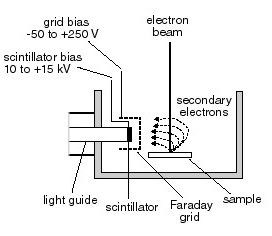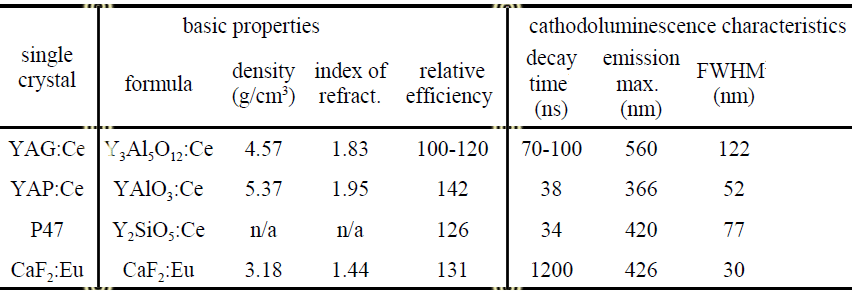=================================================================================
A scintillator emits visible light when irradiated by electrons in electron microscopes, similar to the mechanism of cathodoluminescent process that occurs in fluorescent screens. When we are viewing a static image, we use a long delay scintillator because long delay here does not affect "real-time" observation but enhance signal to noise ratio. However we want the light emission to decay rapidly when we are detecting rapid changes in signal as in scanning beam imaging. In this case, materials such as Ce-doped yttrium-aluminum garnet (YAG), and various doped plastics and glasses are used in scintillator detectors rather than ZnS materials. The decay time of YAG and ZnS materials are on the orders of nanoseconds and microseconds, respectively. Scintillators are widely used in electron microscopes. Figure 4908a and 4908b shows the schematics of SE detector and GIF camera, indicating the position of scintillators in the systems.

Figure 4908a. Schematic of scintillator in SEM systems.

Figure 4908b. Position of scintillator in Gatan GIF camera (see the bottom image).
The scintillators used in electron microscopes are normally coated with a 100-nm-thick layer of Al to reflect any light generated in the microscopes and prevent it from entering the photomultiplier (PM) tube that could add noise to the signal. There are many sources generating lights, for instance, coming from the specimen due to cathodeluminescence, coming down the column from a thermionic source in the column, coming from in situ heating of samples, coming from the viewing chamber of TEM originated from the room illumination, and reflecting from the polished surface of the specimen.
Some properties of single crystal scintillators are listed in Table 4908 [1]. The most important parameter is conversion efficiency of a scintillator. The most often used is YAG:Ce single crystal, which is not the most optimal scintillator but is relatively cheap. The table shows the better choice is the YAP:Ce one.
Table 4908. Properties
of some single crystal scintillators.

[1] P. Schauer and R. Autrata, Optimization of scintillation detector for SEM, EMC 2004 - Proceedings of the 13th European Microscopy Congress.
|


